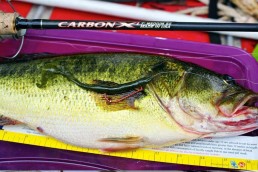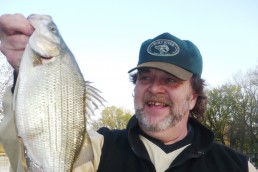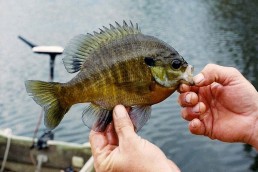You Can Bank on May
SHARE THIS POST
During most of the year, the best bass fishing on big reservoirs like Barkley and Kentucky lakes is out on the ledges. These channel drops, river bends and similar structures are out in the middle of nowhere, and unless you know the lake well, they can be difficult to find and fish.
May, however, is the exception. Everybody, no matter where they’re from or how much they know about fishing, can catch bass like a pro during the flowering month, including the big fish. All you need is a couple of spinnerbaits or crankbaits and a free weekend.
Bass fishing during May in fact is so good and easy that every year one hears a bit of grumbling about how they should “outlaw bass fishing during the spawning period.” Those who make such claims pose logical sounding arguments about protecting the resources, but I suspect their underlying motives are about protecting their reputations.
The most admired fishermen and guides on these big lakes grumble because they have spent countless hours investigating the invisible reaches of underwater breaks far from the banks. During most of the year, these hidden honey holes harbor concentrations of bass that the average angler not only can’t find, but most of them don’t know how to fish them properly if they do happen upon one.
Then along comes the equalizing conditions of spring, and even first-time visitors can make better catches.
I’ve been personally embarrassed myself. During the years that I guided full time, I too began to rely heavily upon these isolated ledges for the bread and butter of my business. A few good ledges can be so consistently productive and seductively secret that you can get stuck on them.
“Only rubes run the banks,” or something to that effect, is what I’ve heard many times. “And all they catch are dinks,” many add.
Well, that may be true during most of the year, especially during the summer, but when bass scatter along the shallows with reproductive intent, running the bank like a weekend “rube” is the best way to make withdrawals from the watery reserves.
Are you enjoying this post?
You can be among the first to get the latest info on where to go, what to use and how to use it!
This free-for-all actually starts when the water rises enough to flood these “yellow flowers.” The powers-that-be typically raises the lake toward summer pool around the first part of April. By the end of April or the first part of May, it floods the mustard flowers that sprout each year in the exposed, soft soil along the banks. The majority of these submerge as the lake reaches summer pool hundreds of feet above sea level. First, big carp move in to spawn very shallow with splashes and thumps, then the bass, with the urge to crowd into and along them, come in great numbers. The biggest bass prowl along the deeper edges and hide out along the bare spots in the middle. The smaller bass weave their way though the underwater jungle of stems.
The most common and easiest method is to run a white or chartreuse spinnerbait right through this stuff. Cast up shallow, hold your rod tip up and reel just fast enough to tickle it through the tangles. Any time you feel the bladed bait pull free into an opening, stop reeling for a moment or drop your rod tip slightly for a second to let the spinnerbait flutter. This is especially effective for the bigger bass that line up along the deep-water edges.
Because it is common and easy, a lot of people cast spinnerbaits into the flowers, and after a while, the bass get wise. When this happens you can ease a plastic worm or lizard Texas-rigged with 1/8-ounce weight lighter through the flowers and catch bass right behind spinnerbait fishermen.
Another popular method utilizes lipless crankbaits and blade baits after the water begins to warm into the upper 60s and the bass become more aggressive. The most popular of these lures for spring are Rat-L-Traps, in either Chrome with a Blue back or in the Crawfish colors. These are “ripped” through the flowers by jerking the rod tip to the side, allowing them to hesitate and fall for an instant as soon as they free the tangles.
Flooded flowers aren’t the only things that hold May bass on the banks. You can simply run the banks with either spinnerbaits or lipless crankbaits, casting blindly or at visible structure and do well—so well in fact you can make some of the ledge-hovering experts jealous.
Ron Kruger has been communicating the outdoor experience for over four decades. He has worked as a full-time guide for trout on the North Fork, for crappies and bass on Kentucky Lake and for smallmouths on the Current River. He has served as editor of three outdoor magazines, and owns a patent on a fly/lure called the Desperate Diver.
MWO
SHARE THIS POST
Did you enjoy this post?
You can be among the first to get the latest info on where to go, what to use and how to use it!
Ron Kruger
Ron Kruger has been communicating the outdoor experience for more than four decades. He has worked as a full-time guide for trout on the North Fork, for crappies and bass on Kentucky Lake and for smallmouths on the Current River. He has served as editor of three outdoor magazines, and owns a patent on a fly/lure called the Desperate Diver.



